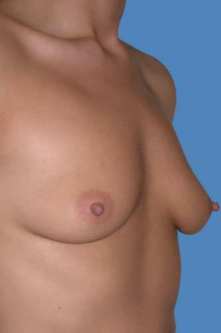
Jordan's Boob Jobs Are Big News
We all know the desired effect of a boob job, the media have followed the ups and downs of Jordon´s cleavage avidly, but do we really know exactly what's involved in a breast augmentation operation? Female First bring you the facts....
With so much media coverage on the results it isn´t surprising that many of us don´t know about the mechanical makings of a double D. When it comes to the procedures, health risks and costs we are left in the dark.
If you are contemplating breast enhancement then it is important that you have all the facts so you make the right decision. We spoke to Dr Andrea Marando, an experienced cosmetic surgery consultant, to get the lowdown on the operation, recovery and most importantly the risks.

Before Surgery
Dr Marando has had over ten years experience in cosmetic surgery and is no stranger to the boom in the number of people going under the knife and the effect that has on their lives.
Most of us have a preconception that it's the wannabe glamour model or spoilt little rich girls that have a boob job, however Dr Marando has found that this isn't the case. In fact most of his patients visit him after pregnancy. This is very common as women find their breasts tend to change shape after breast feeding.
Dr Marando said: "Sometimes due to pregnancies and breast feeding the breasts have changed their shape so they would prefer to have a smaller up-lifted version so t the breast is fuller in the upper part and it´s a rejuvenation of the breast together with an enhancement.
When it comes to operating it is not a case of one method suits all, the type of surgery is dependent on the patient and this will be decided through consultations with your plastic surgeon. Dr Marando told us: "There are different techniques for breast surgery. For one patient there is not just the one method."
Basically the procedure involves the patient being under general anesthetic while a small discrete incision is made underneath the breast or at the edge of the nipple.
The surgeon then makes a pocket under the breast tissue, or chest muscle to place the implant.
There are different options as to where the incision is made and they each result in different degrees of scaring. Going through the nipple is the method which is most popular with Page 3 girls and those whose profession requires them to have as little scars as possible.

After Surgery
Dr Marando says new techniques make the operation even more simple: "The most important and best known technique is called Endoscopic surgery. It´s an American technique that has been devised a few years ago and if you like is the best and safest technique in the hands of a surgeon in the theatre."
This method involves a tubular probe with a tiny camera and bright light being inserted through a really small incision.
A viewing screen, which magnifies the transmitted images of the body's internal structures to a screen, then allows the surgeon to see what he is doing.
The patient is usually required to stay in the hospital for one or two days after the operation. It is important when planning your surgery that you allow yourself enough recovery time after it. The time it takes to heal varies from patient to patient.
Dr Marando said: "It depends on the lifestyle and depends on how fit the patient is and also depends on which kind of profession they have, so if the patient is 25 she has two children and has a good pain threshold she could be back to normal life between 10 to 12 days. If the patient is 20 and she has no pain threshold and no children it might take a few more days."
Those who have had children and therefore have a much higher tolerance to pain are more likely to recover sooner. Dr Marando believes this is why older women aged 50 to 60 have a quicker healing time than young women in their twenties. He said: "The figures have increased between the 40´s and 50´s now, which is if you like the second youth of women and with their pain threshold they tend to recover very quickly sometimes they go back to work within one week."
Even after this period of recovery it is vital to check your breasts frequently as the main risk after surgery is an infection. Dr Marando says the risk of having an infection leading to a problem is a one in 400 chance but it is still important to regularly check for swelling, redness, tenderness and discharge.
Before your breast augmentation surgery, be sure to discuss the signs of an infection and how to prevent one with your surgeon. Dr Marando said that patients should be provided with medication to prevent infection: "Every patient has a dosage of antibiotics to use. Usually, in the hands however of a sensible patient and a skilled surgeon the risk can be reduced."
Even though the operation is over, things can still go wrong. Always keep contact details of your surgeon in case any problems arise (concerning the breasts not in general!) Good surgeons will always encourage visits where they can check on your progress. Dr Marando offers all his patients future check ups which can be made yearly or as many times as they like.
Dr Marando said: "Then you can assess the patient´s progress, the patient can also be sent for ultrasounds, anagrams or magnetic revna which means if the patient is healthy they can keep the implants."
It sounds like a lengthy procedure but for the perfect pair the time must be spared.
For further information concerning cosmetic surgery visit Dr Andrea Marando´s homepage at www.andreamarando.com

